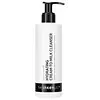What's inside
What's inside
 Key Ingredients
Key Ingredients

 Benefits
Benefits

 Concerns
Concerns

 Ingredients Side-by-side
Ingredients Side-by-side

Water
Skin ConditioningGlycerin
HumectantEthylhexyl Palmitate
EmollientC12-15 Alkyl Benzoate
AntimicrobialPEG-6 Caprylic/Capric Glycerides
EmulsifyingBetaine
HumectantPolyglyceryl-3 Dicitrate/Stearate
EmulsifyingSodium Acrylate/Sodium Acryloyldimethyl Taurate Copolymer
Emulsion StabilisingIsohexadecane
EmollientPentylene Glycol
Skin ConditioningPropanediol
SolventButyrospermum Parkii Butter
Skin ConditioningHydroxyacetophenone
AntioxidantOryza Sativa
Caprylyl Glycol
EmollientCetearyl Olivate
Polysorbate 80
EmulsifyingSorbitan Olivate
EmulsifyingEthylhexylglycerin
Skin ConditioningSodium Hydroxide
BufferingSorbitan Oleate
EmulsifyingXanthan Gum
EmulsifyingHydrolyzed Rice Protein
Skin ConditioningOryza Sativa Bran Oil
EmollientInulin
Skin ConditioningPolyquaternium-10
Hydrolyzed Sodium Hyaluronate
Skin ConditioningSodium Hyaluronate
HumectantPhenoxyethanol
PreservativeLecithin
EmollientWater, Glycerin, Ethylhexyl Palmitate, C12-15 Alkyl Benzoate, PEG-6 Caprylic/Capric Glycerides, Betaine, Polyglyceryl-3 Dicitrate/Stearate, Sodium Acrylate/Sodium Acryloyldimethyl Taurate Copolymer, Isohexadecane, Pentylene Glycol, Propanediol, Butyrospermum Parkii Butter, Hydroxyacetophenone, Oryza Sativa, Caprylyl Glycol, Cetearyl Olivate, Polysorbate 80, Sorbitan Olivate, Ethylhexylglycerin, Sodium Hydroxide, Sorbitan Oleate, Xanthan Gum, Hydrolyzed Rice Protein, Oryza Sativa Bran Oil, Inulin, Polyquaternium-10, Hydrolyzed Sodium Hyaluronate, Sodium Hyaluronate, Phenoxyethanol, Lecithin
Water
Skin ConditioningCyclopentasiloxane
EmollientCarthamus Tinctorius Seed Oil
MaskingGlycerin
HumectantPropylene Glycol
HumectantSimmondsia Chinensis Seed Oil
EmollientLeuconostoc/Radish Root Ferment Filtrate
AntimicrobialPEG/PPG-18/18 Dimethicone
EmulsifyingCarbomer
Emulsion StabilisingXanthan Gum
EmulsifyingBenzyl Alcohol
PerfumingSodium Hydroxide
BufferingAloe Barbadensis Leaf Juice
Skin ConditioningCaprylic/Capric Triglyceride
MaskingPEG-8
HumectantSodium Gluconate
Skin ConditioningAllantoin
Skin ConditioningCaprylhydroxamic Acid
Cetearyl Alcohol
EmollientPunica Granatum Extract
AstringentCitrus Limon Peel Oil
MaskingVitis Vinifera Seed Extract
AntimicrobialStearic Acid
CleansingCetyl Alcohol
EmollientPhenoxyethanol
PreservativeDicaprylyl Ether
EmollientSqualane
EmollientAloe Barbadensis Leaf Juice Powder
Skin ConditioningMagnesium Aluminum Silicate
AbsorbentPolysorbate 60
EmulsifyingCitrus Aurantium Dulcis Flower Oil
AstringentPEG-150 Stearate
Polysorbate 80
EmulsifyingEthylhexylglycerin
Skin ConditioningO-Cymen-5-Ol
AntimicrobialCeteareth-20
CleansingPEG-20 Hydrogenated Lanolin
EmollientPEG-40 Stearate
EmulsifyingFructooligosaccharides
HumectantGlucosamine Hcl
Citric Acid
BufferingWater, Cyclopentasiloxane, Carthamus Tinctorius Seed Oil, Glycerin, Propylene Glycol, Simmondsia Chinensis Seed Oil, Leuconostoc/Radish Root Ferment Filtrate, PEG/PPG-18/18 Dimethicone, Carbomer, Xanthan Gum, Benzyl Alcohol, Sodium Hydroxide, Aloe Barbadensis Leaf Juice, Caprylic/Capric Triglyceride, PEG-8, Sodium Gluconate, Allantoin, Caprylhydroxamic Acid, Cetearyl Alcohol, Punica Granatum Extract, Citrus Limon Peel Oil, Vitis Vinifera Seed Extract, Stearic Acid, Cetyl Alcohol, Phenoxyethanol, Dicaprylyl Ether, Squalane, Aloe Barbadensis Leaf Juice Powder, Magnesium Aluminum Silicate, Polysorbate 60, Citrus Aurantium Dulcis Flower Oil, PEG-150 Stearate, Polysorbate 80, Ethylhexylglycerin, O-Cymen-5-Ol, Ceteareth-20, PEG-20 Hydrogenated Lanolin, PEG-40 Stearate, Fructooligosaccharides, Glucosamine Hcl, Citric Acid
 Reviews
Reviews

Ingredients Explained
These ingredients are found in both products.
Ingredients higher up in an ingredient list are typically present in a larger amount.
Ethylhexylglycerin (we can't pronounce this either) is commonly used as a preservative and skin softener. It is derived from glyceryl.
You might see Ethylhexylglycerin often paired with other preservatives such as phenoxyethanol. Ethylhexylglycerin has been found to increase the effectiveness of these other preservatives.
Glycerin is already naturally found in your skin. It helps moisturize and protect your skin.
A study from 2016 found glycerin to be more effective as a humectant than AHAs and hyaluronic acid.
As a humectant, it helps the skin stay hydrated by pulling moisture to your skin. The low molecular weight of glycerin allows it to pull moisture into the deeper layers of your skin.
Hydrated skin improves your skin barrier; Your skin barrier helps protect against irritants and bacteria.
Glycerin has also been found to have antimicrobial and antiviral properties. Due to these properties, glycerin is often used in wound and burn treatments.
In cosmetics, glycerin is usually derived from plants such as soybean or palm. However, it can also be sourced from animals, such as tallow or animal fat.
This ingredient is organic, colorless, odorless, and non-toxic.
Glycerin is the name for this ingredient in American English. British English uses Glycerol/Glycerine.
Learn more about GlycerinPhenoxyethanol is a preservative that has germicide, antimicrobial, and aromatic properties. Studies show that phenoxyethanol can prevent microbial growth. By itself, it has a scent that is similar to that of a rose.
It's often used in formulations along with Caprylyl Glycol to preserve the shelf life of products.
Polysorbate 80 is a surfactant and emulsifier. It is used to keep ingredients together, and prevent oils and waters from separating.
It is made from polyethoxylated sorbitan and oleic acid. This ingredient can be found in cosmetics, foods, and medicine. It is water-soluble.
Polysorbate 80 may not be fungal acne safe.
Learn more about Polysorbate 80Sodium Hydroxide is also known as lye or caustic soda. It is used to adjust the pH of products; many ingredients require a specific pH to be effective.
In small amounts, sodium hydroxide is considered safe to use. However, large amounts may cause chemical burns due to its high alkaline.
Your skin has a natural pH and acid mantle. This acid mantle helps prevent harmful bacteria from breaking through. The acid mantle also helps keep your skin hydrated.
"Alkaline" refers to a high pH level. A low pH level would be considered acidic.
Learn more about Sodium HydroxideWater. It's the most common cosmetic ingredient of all. You'll usually see it at the top of ingredient lists, meaning that it makes up the largest part of the product.
So why is it so popular? Water most often acts as a solvent - this means that it helps dissolve other ingredients into the formulation.
You'll also recognize water as that liquid we all need to stay alive. If you see this, drink a glass of water. Stay hydrated!
Learn more about WaterXanthan gum is used as a stabilizer and thickener within cosmetic products. It helps give products a sticky, thick feeling - preventing them from being too runny.
On the technical side of things, xanthan gum is a polysaccharide - a combination consisting of multiple sugar molecules bonded together.
Xanthan gum is a pretty common and great ingredient. It is a natural, non-toxic, non-irritating ingredient that is also commonly used in food products.
Learn more about Xanthan Gum